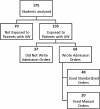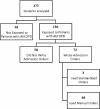Evaluation of standardized doctor's orders as an educational tool for undergraduate medical students: a prospective cohort study
- PMID: 23842504
- PMCID: PMC3710495
- DOI: 10.1186/1472-6920-13-97
Evaluation of standardized doctor's orders as an educational tool for undergraduate medical students: a prospective cohort study
Abstract
Background: Standardized doctor's orders are replacing traditional order writing in teaching hospitals. The impact of this shift in practice on medical education is unknown. It is possible that preprinted orders interfere with knowledge acquisition and retention by not requiring active decision-making. The objective of the study was to evaluate the impact of standardized admission orders on disease-specific knowledge among undergraduate medical trainees.
Methods: This prospective cohort study enrolled Year 3 (n = 121) and Year 4 (n = 54) medical students at two academic hospitals in Toronto (Ontario, Canada) during their general internal medicine rotation. We used standardized orders for patient admissions for alcohol withdrawal (AW) and for acute exacerbations of chronic obstructive pulmonary disease (AECOPD) as the intervention and manual order writing as the control. Educational outcomes were assessed through end-of-rotation questionnaires assessing disease-specific knowledge of AW and AECOPD.
Results and discussions: Of 175 students, 105 had exposure to patients with alcohol withdrawal during their rotation, and 68 students wrote admission orders. Among these 68 students, 48 used standardized orders (intervention, n = 48) and 20 used manual order writing (control, n = 20). Only 3 students used standardized orders for AECOPD, precluding analysis. There was no significant difference found in mean total score of questionnaires between those who used AW standardized orders and those who did not (11.8 vs. 11.0, p = 0.4). Students who had direct clinical experience had significantly higher mean total scores (11.6 vs. 9.0, p < 0.0001 for AW; 13.8 vs. 12.6, p = 0.02 for AECOPD) compared to students who did not. When corrected for overall knowledge, this difference only persisted for AW.
Conclusions: No significant differences were found in total scores between students who used standardized admission orders and traditional manual order writing. Clinical exposure was associated with increase in disease-specific knowledge.
Figures



Similar articles
-
Comparison of Lecture-Based Learning vs Discussion-Based Learning in Undergraduate Medical Students.J Surg Educ. 2016 Mar-Apr;73(2):250-7. doi: 10.1016/j.jsurg.2015.09.016. Epub 2015 Nov 10. J Surg Educ. 2016. PMID: 26572094 Clinical Trial.
-
Evaluation of the Characteristics of a Workplace Assessment Form to Assess Entrustable Professional Activities (EPAs) in an Undergraduate Surgery Core Clerkship.J Surg Educ. 2018 Sep-Oct;75(5):1211-1222. doi: 10.1016/j.jsurg.2018.02.013. Epub 2018 Mar 31. J Surg Educ. 2018. PMID: 29609893
-
Effectiveness of problem based learning as an instructional tool for acquisition of content knowledge and promotion of critical thinking among medical students.J Coll Physicians Surg Pak. 2013 Jan;23(1):42-6. J Coll Physicians Surg Pak. 2013. PMID: 23286622
-
Impact of an Interactive Vascular Surgery Web-Based Educational Curriculum on Surgical Trainee Knowledge and Interest.J Surg Educ. 2017 Mar-Apr;74(2):251-257. doi: 10.1016/j.jsurg.2016.09.003. Epub 2016 Oct 7. J Surg Educ. 2017. PMID: 27727138 Clinical Trial.
-
Outcomes and satisfaction of two optional cadaveric dissection courses: A 3-year prospective study.Anat Sci Educ. 2017 Mar;10(2):127-136. doi: 10.1002/ase.1638. Epub 2016 Aug 2. Anat Sci Educ. 2017. PMID: 27483443
References
-
- Rozich JD, Howard RJ, Justeson JM, Macken PD, Lindsay ME, Resar RK. Standardization as a mechanism to improve safety in health care. Jt Comm J Qual Saf. 2004;30:5–14. - PubMed
-
- Ozdas A, Speroff T, Waitman LR, Ozbolt J, Butler J, Miller RA. Integrating “best of care” protocols into clinicians’ workflow via care provider order entry: impact on quality-of-care indicators for acute myocardial infarction. J Am Med Inform Assoc. 2006;13:188–196. doi: 10.1197/jamia.M1656. - DOI - PMC - PubMed
-
- Doolan DF, Bates DW. Computerized physician order entry systems in hospitals: mandates and incentives. Technology & Medicine. 2002;21(4):180–188. - PubMed
Publication types
MeSH terms
LinkOut - more resources
Full Text Sources
Other Literature Sources

